
Fractures Page Menu: 1 2 3 4 5 6 7 8 9 10 11 12 Next>>
Fracture Treatment During the Golden Age of Piracy, Page 5
Restoring the Bone: Sawing the Bone
Period surgeons sometimes recommend cutting the end of the broken bone off when the fracture is compounded with a wound that allows access to the bones.
Hippocrates advises doing so when one end of the broken bone protrudes from the wound. He first recommends that the surgeon cut the end of the protruding bone "if it cannot be reduced [put back in line with its mate], and if it appears that only a small piece is required [to be removed] in order that it may get back into its place"1. He leaves determination of how much to cut to the surgeon, which would have to be handled on a case by case basis.
Richard
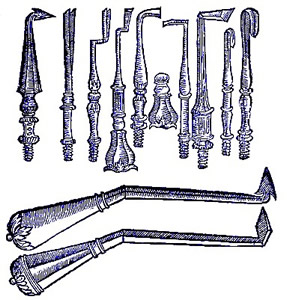
Various Bone Cutting Tools
from Ambroise Paré's
The Workes of That Famous Chirurgeon Ambrose Parey,
p. 267 (1649)
Wiseman agrees, explaining "if the end of the bared Bone do chance to thrust it self out, as that without great force it cannot be restored to its place... then that end of the Bone which hath thrust it self so far out is to be sawed off: and if this be done timely, before a Gangrene hath seized upon the Part, it may be performed with good success."2
Ambroise Paré also advises if the bone is "so prominent out of the wounded flesh as that it cannot be restored into its seat, it must be cut off with your cutting mallets, or parrats beake, as occasion shall offer its selfe."3 By "cutting mallets" he is referring various sorts of bone chisels which can be seen at left. A parrot's beak refers to hand-held curved cutting tools such as those seen below right.
Paré additionally suggests cutting the end of the bone off when it "be broken into splinters"4. He is the only surgeon under study to suggest this, perhaps because it seems more reasonable to try fitting the bone ends together before cutting the jagged ends.
Hippocrates also suggests sawing when the broken end of bone "occasions inconvenience and irritates any part of the flesh, and prevents the limb from being properly laid"5. This instruction is a bit vague, particularly when the surgeon must determine what 'inconvenience' might mean.
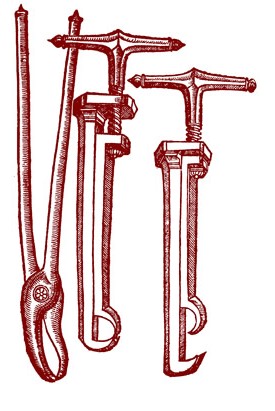
Parrot's Beak Cutting Tools
from Ambroise Paré's
The Workes of That Famous Chirurgeon
Ambrose Parey,
p. 270 (1649)
Presumably it should be cut if it irritates the patient when put back into place, suggesting there may be loose fragment jabbing the flesh around the restored bone. There is a lot of room left for interpretation, however. Hippocrates does later explain that for either of these first two situations, "it is not of much consequence whether they be sawed off or not."6
Hippocrates last reason for sawing of the end of a fractured bone is interesting.
[I]f, moreover, it be denuded of flesh, such a piece of bone should be taken off. ...For it should be known for certain, that such bones as are completely deprived of flesh, and have become dried, all separate completely. Those which are about to exfoliate [cast off dead parts of the bone] should not be sawn off. Those that will separate completely must be judged of from the symptoms that have been laid down.7
Separation is a curious term. Hippocrates appears to be referring to the death of the part of the bone which has lost its periosteum (the tough outer membrane covering the bones). In fact, sawing of bones that lost their periosteum was widely practised from the time of Hippocrates, through the golden age of pirates well into the 19th century. Dr. Benjamin W. Dudley of is credited with this discovery that broken bones could rebuilt periosteum as early as 18248 - about 100 years after the golden age of piracy. Today we know that repair of the periosteum can occur inside the blood clot that forms around the broken bone.9
Richard Wiseman explains a rather involved surgical procedure for cutting off a broken shine bone with some interesting features. Wiseman explains that
the Bone [was] thrust out so far, that there was no hopes of its being any more reduced by a new Extension. Upon which consideration we resolved to saw off the end of it: and to that purpose having prepared all things ready, we ....turned the Foot on one Side towards the Small of the leg, thrusting the Bone more out; the one [probably Wiseman] sawing the end off, while the other [probably Mr. Tatham, 'an industrious knowing Chirurgeon'] with a Spatula defended the Tendonous flesh underneath from being wounded by the Saw. That done we cleansed the Wound from the Saw-dust, as also from the Shivers of little Bones which we had not discovered in our first dressing, they laying pricking the Periosteum, between the fractured Bones and Membranes, by which those sad Accidents had been hastened. The Wound thus cleansed, we turned the Foot right into its natural place, there being no need of Extension10
Among the points of interest were turning the foot so that the bone could be more easily cut (which must have hurt the patient abominably), the use of the spatula - a small, flat metal tool - to protect the skin while sawing, and cleansing the wound of the bone dust generated by sawing. Notice that Paré's tools were not toothed and so would not create bone dust.
1 Hippocrates, Hippocratic Writings, Translated and Edited by Francis Adams, p. 88; 2 Richard Wiseman, Of Wounds, Severall Chirurgicall Treatises, p. 475; 3,4 Ambroise Paré, The Apologie and Treatise of Ambroise Paré, p.172; 5,6,7 Hippocrates, ibid.; 8 Theodore S. Bell, A Pseudo-critic Unmasked, p. 26-7; 9 See Jerry R. Dwek, "The periosteum: what is it, where is it, and what mimics it in its absence?", Skeletal Radiol, 2010, p. 322; 10 Wiseman, p. 476
Restoring the Bone: Checking the Result
Since they did not have X-rays to aid them, golden age of pirate-era surgeons had to use more primitive ways to check that a bone was properly set. Several indications are used during the golden age of piracy including the alignment of a limb, the cessation of pain, and feeling the bones.
Restoring the Bone: Checking the Result - The Alignment
Hippocrates advised that "nothing should be omitted in order that the parts may be properly distended and put in a straight line"1. He was particularly concerned about improperly set
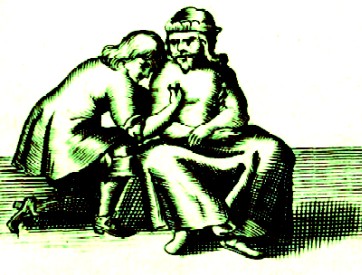
Artist:Jonas Arnold Delineavi
Checking by Examination, From Armamentarium Chirurgicum Bipartitum
by Johannes Scultetus, Table 24, p. 607 (1666)
legs, "for it is a great disgrace and an injury to exhibit a shortened thigh. For the arm, when shortened, might be concealed, and the mistake would not be great; but a shortened thigh-bone would exhibit the man maimed."2 He goes so far as to say "it would be to the advantage of a person who would be improperly treated that both his legs should be broken, rather than either of them; for in this case the one would be of the same length as the other."3 (Which would only be true if they were both improperly healed in the same way.) To avoid this, he recommends that during extension the bone "must naturally be made straight in a line with the leg and thigh."4
Ambroise Paré says that one of the things indicating a bone is properly set is when "the broken or dislocated member compares with its opposite in the composure of the joynts, as the knees and ancles answer justly and equally in length and thicknesse. For which purpose it must not suffice the Surgeon to view it once, but even as often as he shall dresse [bandage] it."5 Sea surgeon John Woodall poetically agrees, noting that when a fracture is properly set "the member is returned to his former beauty again"6.
Restoring the Bone: Checking the Result - Cessation of Pain
Paré provides another way to check the bones, telling his readers that "the [bone] setting performed as is fit, if the paine be asswaged; to wit, the fibres of the muscles, and the other parts being restored to their former site, and all compression, which the bones moved out of their places have made, being taken away"7. John Woodall again agrees, noting that the fracture is well set "if much of the paine is eased, for it is a sure rule, if the paine abate not, all is not well"8. Richard Wiseman also recognizes pain abatement as a key sign for an effective setting.9
Restoring the Bone: Checking the Result - Feeling the Setting
While most of the other surgeons recommended one or both of the previous two methods for checking to see if a bone has been properly set, John Atkins has a different idea. Regarding the previous two methods of testing the setting, he tells readers such methods "are all very fallible and uncertain."10 He goes on to explain that
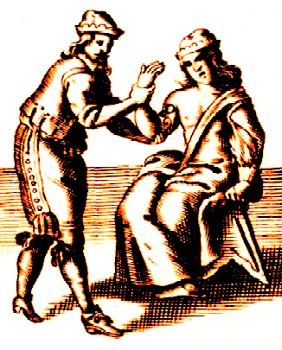
Artist:Jonas Arnold Delineavi
Checking by Feel, From Armamentarium Chirurgicum
Bipartitum by Johannes Scultetus, Table 24, p. 607
(1666)
as to its Resemblance with the sound Member, I cannot form to my self any sure Rules of judging after the Dressings are on; for, what Likeness soever they might have had before it will be lost then; and in this we are never so frequently deceived as in the Thigh; for Pain, with the Weight and Unweildiness of the Member, always sinks the Patient to the hurt Side, and imposes on us a false Length; so that I have seen a Thigh, which by its Appearance in a Cradle, has been thought to be longer than the other, prove, when come to be made use of, an Inch or two shorter.11
How can the setting a fracture be measured according to Atkins? "[I]t is your Feeling now [with your hands] that must afford you the true and only Signs that you can or will have of a smooth and even Coaptation"12.
Matthias Gottfried Purmann agrees with Atkins that feeling a fracture to check it is the only way to properly check the results.
When the Bones are rightly Set, which you may easily perceive the by the Streightness, Form and Agreeableness of the part, and which the Chirurgeon may feel with his hand, or by gently stroaking down his right Thumb in a Streight Line directly over the Fracture; for if he finds nothing uneven under his Thumb, the work is done as it ought to be.13
While it may not be their only choice, most of the other surgeons agree that checking the bone by feeling with their hands is effective. Paré says the bone is well set "if, to your feeling there bee nothing bunching out, nor rugged, but the surface of the member remaine smooth and equall"14. Wiseman says you tell a well-set fracture "if by your handling of it you feel no Inequality"15. He also advises using a sound (a metal probing tool) to check the fracture.16
1,2 Hippocrates, Hippocratic Writings, Translated and Edited by Francis Adams, p. 82; 3 Hippocrates, p. 82-3; 4 Hippocrates, p. 81; 5 Ambroise Paré, The Apologie and Treatise of Ambroise Paré, p.169; 6 John Woodall, the surgions mate, p. 164; 7Paré, p.169; 8 Woodall, ibid.; 9 Richard Wiseman, Of Wounds, Severall Chirurgicall Treatises, p. 467; 10 John Atkins, The Navy Surgeon, p. 41; 11 Atkins, p. 42; 12 Atkins, p. 41-2; 13 Matthias Gottfried Purmann, Churgia Curiosa, p. 213; 14 Paré, p.168-9; 15,16 Wiseman, p. 467
Restoring the Bone: Distortion
Hippocrates says that a fracture which did not heal properly "is a great disgrace"1. There could be several reasons for the bone to heal in a distorted manner
One way this could occur is by improper setting of the bone by the surgeon. According to sea surgeon John Atkins, "This happens by ill Reduction at first, or Mismanagement afterwards."2 He explains that ill reduction [a badly set bone] occurs "when the Ends of the Bone do not answer Fibre to Fibre; and this, in all likelihood, they will be the widest from, where the Obliquity of the Fracture is greatest."3

Distorted Forearm
from Der
arztliche Ratgeber in Wort
und Bild (1910)
Atkins explains that mismanagement occurs when
we neglect the Position [of the bone while the callus forms], and so in Proportion as it is wreathed to one side, or the Heel [of the foot] is raised or let fall too much, and inadvertently continued so, the Edges of the Bone meet closer in one Part, and recede in the Opposite; which Space or Vacuity filling with the Matter of a Callus, brings a Curvity [to the healed bone].4
Paré likewise mentions ill-formed bones, caused "by the Patients unconsiderate turning himselfe in his bed, or as it were a convulsive twitching of the members or joints whilest he sleepes, the muscles of their owne accord contracting themselves towards their originals, that the member may againe fall out [of place]"5. When this occurs, Paré says that "it will give manifest signes thereof by renewing the paine, by pressing or pricking the adjacent bodies: which paine will not cease"6. He warns that
the Surgeon ought to have diligent care. For if, whilest the Callus is in growing, one bone ride over another, the bone it selfe will afterwards be so much the shorter, and consequently the whole member; so that if this errour shall happen in a broken legge, the Patient will halt ever after, to his great griefe, and the Surgeons shame.7
His solution is to have the surgeon advise the patient "that he stirre not the broken member, before that the Callus be hardened."8
Richard Wiseman finds both of the above - poor setting and movement on the part of the patient during healing - to be potential causes of distortion in healed fractures. He adds that deformed healing can occur "through ill Bandage"9.
The solution Wiseman mentions is re-breaking the bone if it is not fully healed. He explains that Celsus and Hieronymus Fabricius both suggest that "If the Patient be young and lusty, and the Callus but six months old, there is yet one refuge, that is, fracturam de novo rumpere [break the bone in the same place]"10 However he also notes "that after the Callus is so confirmed that it will not yield to Extension, then if you should break it anew, or any other way separate it; yet it would no more yield to a right Coaptation [rejoining of the bones] ...without separating the Callosity; which is not possible to be done in [fully healed] Bones."11
As Wiseman suggests, once a fracture healed there was little the surgeon could do. Atkins explains improperly healed fractures were "past any other Remedy, but the preposterous one of Breaking [the bone] again."12 This would be extraordinarily hard to do, given that a fully healed fracture is as strong as any other part of the bone around it.
1 Hippocrates, Hippocratic Writings, Translated and Edited by Francis Adams, p. 82; 2,3,4 John Atkins, The Navy Surgeon, p. 49; 5,6,7,8 Ambroise Paré, The Apologie and Treatise of Ambroise Paré, p.169; 8,9,10 Richard Wiseman, Of Wounds, Severall Chirurgicall Treatises, p. 472; 12 Atkins, ibid.
Restoring the Bone: Non-Limb Fractures
Most of the material on fractures discussed by period authors focus on arms and legs, perhaps because they are the most likely to be broken and they required extension and setting by a surgeon and his assistants.
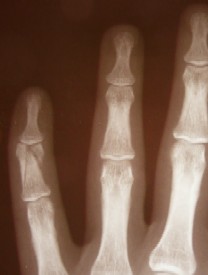
Photographer: Nevit Dilmen
Fracture of the Middle Phalanx of
The Pinky Finger
However, there are a some non-limb fractures discussed by period surgeons. You may recall the case William Clowes discusses concerning a fractured rib. Clowes did not set the bone, rather he simply put medicine and bandages on it.1 Richard Wiseman discusses a case where he repairs a fractured collar bone, although all he has to say about restoring the bone is that it was "set and bound up, with resolution not to open it till it should be united."2
While hands and feet are technically parts of the limbs, they contain many small bones in great density, so they are treated separately in period medical books. With regard to fingers, John Atkins says that "the straightening of a Finger is the replacing of it; if any Particle of Bone is an Obstruction to this, or separated, it is to be removed; and if the Wound be so large as to shew the Bone, it should be covered with dry Lint, or a Dossil [roll of lint] pressed out of Tinct. Myrrh.[a cleansing and healing medicine]."3
Woodes Rogers reported that after being wounded in the foot, "several Pieces of my Foot and Heel-bone taken out, but God be thanked, am now in a fair way to have the Use of my Foot and recover my Health."4 His Journal records that he was immobile for some time after that wound, in part because he couldn't walk very well. It may also been because immobility was needed for the foot to heal, although this is not specifically stated.
1 William Clowes, A Profitable and Necessarie Booke of Observations, 3rd. ed., p. 77; 2 Richard Wiseman, Of Wounds, Severall Chirurgicall Treatises, p. 473; 3 John Atkins, The Navy Surgeon, p. 53; 4 Woodes Rogers, A Cruising Voyage Round the World, p. 205

